Students can use CBSE Previous Year Question Papers Class 10 Maths with Solutions and CBSE Class 10 Maths Question Paper 2023 (Series: WX1YZ/6) to familiarize themselves with the exam format and marking scheme.
CBSE Class 10 Maths Question Paper 2023 (Series: WX1YZ/6) with Solutions
Time allowed: 3 hours
Maximum marks: 80
General Instructions:
Read the following instructions carefully and follow them:
- This question paper contains 38 questions. All questions are compulsory.
- Question paper is divided into FIVE Sections – Section A, B, C, D and E.
- In Section A – Question no. 1 to 18 are Multiple Choice Questions (MCQ) and Question number 19 and 20 are Assertion-Reason based questions of 1 mark each.
- In Section B – Question number 21 to 25 are Very Short Answer (VSA) type questions of 2 marks each.
- In Section C – Question number 26 to 31 are Short Answer (SA) type questions, carrying 3 marks each.
- In Section D – Question number 32 to 35 are Long Answer (LA) type questions carrying 5 marks each.
- In Section E – Question number 36 to 38 are case study based integrated units of assessment questions
carrying 4 marks each. Internal choice is provided in 2 mark questions in each Case-study. - There is no overall choice. However, an internal choice has been provided in 2 questions in Section B, 2 questions in Section C, 2 questions in Section D and 3 questions in Section E.
- Draw neat figures wherever required. Take π = 22/7 wherever required if not stated.
- Use of calculators is NOT allowed.
SET I Code No. 30/6/1
Section – A (Multiple choice questions)
Section A consists of 20 questions of 1 mark each.
Question 1.
If P2 = \(\frac{32}{50}\), then P is a/an
(a) whole number
(b) integer
(c) rational number
(d) irrational number
Answer:
(c) rational number
We have, p2 = \(\frac{32}{50}\) = \(\frac{16}{25}\)
∴ p = ± \(\frac{4}{5}\) (Rational Number)
Question 2.
The distance of the point (-6, 8) from x-axis is
(a) 6 units
(b) -6 units
(c) 8 units
(d) 10 units
Answer:
(c) 8 units
8 units (ordinate)
Question 3.
The number of quadratic polynomials having zeroes -5 and -3 is 1
(a) 1
(b) 2
(c) 3
(d) more than 3
Answer:
(d) more than 3
Sum of zeroes, S = -5 + (-3) = -8
Product of zeroes, P = (-5) x (-3) = 15
∴ Quadratic Polynomial = k (x2 – Sx + P)
= k(x2 + 8x +15) …[Where k is non-zero real number
∴ Infinitely many Quadratic Polynomials are possible.
![]()
Question 4.
The point of intersection of the line represented by 3x – y = 3 and y-axis is given by 1
(a) (0,-3)
(b) (0, 3)
(c) (2, 0)
(d) (-2, 0)
Answer:
(a) (0,-3)
(a) Given. 3x – y = 3
⇒ 0 – y = 3 (At Y-axis Put x = 0)
∴ y = -3 ∴ Point = (x, y) = (0, -3)
Question 5.
The circumferences of two circles are in the ratio 4 : 5. What is the ratio of their radii? 1
(a) 16 : 25
(b) 25 : 16
(c) 2 : √5
(d) 4 : 5
Answer:
(d) 4 : 5
Let c1 and c2 be the circumferences of two circles respectively.
Given. \(\frac{c_1}{c_2}\) = \(\frac{1}{2}\) ⇒ \(\frac{2 \pi r_1}{2 \pi r_2}\) = \(\frac{1}{2}\)
∴ r1 : r2 = 4 : 5
Question 6.
If α and β are the zeroes of the polynomial x2 – 1, then the value of (α + β) is 1
(a) 2
(b) 1
(c) -1
(d) 0
Answer:
(d) 0
Given, x2 – 1 = 0
Here, a = 1, b = 0, c = -1
∴ α + β = \(\frac{-b}{a}=\frac{- \text { coefficient of } x}{\text { coefficient of } x^2}\)
= \(\frac{-0}{1}\) = 0
Question 7.
\(\frac{\cos ^2 \theta}{\sin ^2 \theta}-\frac{1}{\sin ^2 \theta}\), in simplified form, is: 1
(a) tan2 θ
(b) sec2 θ
(c) 1
(d) -1
Answer:
(d) -1
1st Method: \(\frac{\cos ^2 \theta}{\sin ^2 \theta}-\frac{1}{\sin ^2 \theta}\)
= \(\frac{\cos ^2 \theta-1}{\sin ^2 \theta}\) = \(\frac{-\left(1-\cos ^2 \theta\right)}{\sin ^2 \theta}\) = \(\frac{-\sin ^2 \theta}{\sin ^2 \theta}\) = -1
2nd Method: \(\frac{\cos ^2 \theta}{\sin ^2 \theta}-\frac{1}{\sin ^2 \theta}\)
= cot2 θ – cosec2 θ
= -(cosec2 θ – cot2 θ) = -1
Question 8.
If ΔPQR ~ ΔABC; PQ = 6 cm , AB = 8 cm and the perimeter of ΔABC is 36 cm, then the perimeter of ΔPQR is 1
(a) 20.25 cm
(b) 27 cm
(c) 48 cm
(d) 64 cm
Answer:
(b) 27 cm
ΔPQR ~ ΔABC
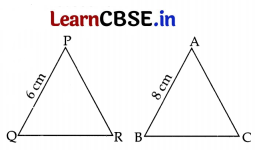
∴ Peri. (ΔPQR) = \(\frac{1}{2}\) × 36 = 27 cm
Question 9.
If the quadratic equation ax2 + bx + c = 0 has two real and equal roots, then ‘c’ is equal to’
(a) \(\frac{-b}{2 a}\)
(b) \(\frac{b}{2 a}\)
(c) \(\frac{-b^2}{4 a}\)
(d) \(\frac{b^2}{4 a}\)
Answer:
(d) \(\frac{b^2}{4 a}\)
D = 0 …[Since Roots are real and equal
⇒ b2 – 4ac = 0 ⇒ b2 = 4ac ∴ c = \(\frac{b^2}{4 a}\)
Question 10.
In the given figure, DE || BC. If AD = 3 cm, AB = 7 cm and EC = 3 cm, then the length of AE is 1
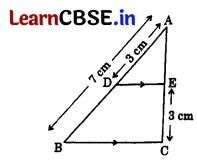
(a) 2 cm
(b) 2.25 cm
(c) 3.5 cm
(d) 4 cm
Answer:
(b) 2.25 cm
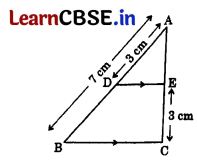
In ΔABC, DE || BC …[Given
\(\frac{\mathrm{AD}}{\mathrm{DB}}\) = \(\frac{\mathrm{AE}}{\mathrm{EC}}\) …[Thales theorem
⇒ \(\frac{3}{7-3}=\frac{\mathrm{AE}}{3}\) ⇒ 4 AE = 9
∴ AE = \(\frac{9}{4}\) = 2.25 cm
![]()
Question 11.
A bag contains 5 pink, 8 blue and 7 yellow balls. One ball is drawn at random from the bag. What is the probability of getting neither a blue nor a pink ball? 1
(a) \(\frac{1}{4}\)
(b) \(\frac{2}{5}\)
(c) \(\frac{7}{20}\)
(d) \(\frac{13}{20}\)
Answer:
(c) \(\frac{7}{20}\)
Total Balls = 5 + 8 + 7 = 20
∴ P (neither a blue nor a pink ball)
= 1 – (\(\))
= 1 – (\(\frac{8+5}{20}\)) =1 – \(\frac{13}{20}\) = \(\frac{7}{20}\)
Question 12.
The volume of a right circular cone whose area of the base is 156 cm2 and the vertical height is 8 cm, is 1
(a) 2496 cm3
(b) 1248 cm3
(c) 1664 cm3
(d) 416 cm3
Answer:
(d) 416 cm3
Volume of cone
= \(\frac{1}{3}\) × (Area of Base) × height
= \(\frac{1}{3}\) × 156 × 8 = 416 cm3
Question 13.
3 chairs and 1 table cost ₹900, whereas 5 chairs and 3 tables cost ₹2,100. If the cost of 1 chair is ₹ x and the cost of 1 table is ₹ y, then the situation can be represented algebraically as 1
(a) 3x + y = 900, 3x + 5y = 2100
(b) x + 3y = 900, 3x + 5y = 2100
(c) 3x + y = 900,5x + 3y = 2100
(d) x + 3y = 900, 5x + 3y = 2100
Answer:
(c) 3x + y = 900,5x + 3y = 2100
3x + 1y = ₹900
5x + 3y = ₹2100
Question 14.
In the given figure, PA and PB are tangents from external point P to a circle with centre C and Q is any point on the circle. Then the measure of ∠AQB is 1
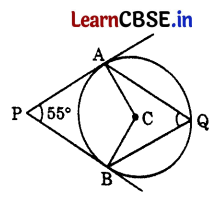
(a) 621/2°
(b) 125°
(c) 55°
(d) 90°
Answer:
(a) 621/2°
AC & BC are radii and PA and PB are tangents.
∠PAC = ∠PBC = 90° …[Tangent is ⊥ to the radius through the point of contact
In quad. PACB,
55° + 90° + ∠ACB + 90° = 360° …[Angle-sum-property of a quadrilateral
⇒ ∠ACB = 360° – 235° = 125°
Now, ∠AQB = ∠ACB
= \(\frac{125}{2}\) = 62\(\frac{1}{2}\)° ….[The angle subtended by an arc at the centre is double the angle subtended by it at any point on the remaining part of circle.
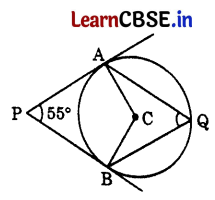
Question 15.
A card is drawn at random from a well shuffled deck of 52 playing cards. 1
The probability of getting a face card is
(a) \(\frac{1}{2}\)
(b) \(\frac{3}{13}\)
(c) \(\frac{4}{13}\)
(d) \(\frac{1}{13}\)
Answer:
(b) \(\frac{3}{13}\)

∴ P (Face Card) = \(\frac{12}{52}\) = \(\frac{3}{13}\)
![]()
Question 16.
If θ is an acute angle of a right angled triangle, then which of the following equations is not true? 1
(a) sin θ cot θ = cos θ
(b) cos θ tan θ = sin θ
(c) cosec2 θ – cot2 θ = 1
(d) tan2 θ – sec2 θ = 1
Answer:
(d) tan2 θ – sec2 θ = 1
Identity: sec2 θ – tan2 θ = 1
so, tan2 θ – sec2 θ ≠ 1
Question 17.
If the zeroes of the quadratic polynomial x2 + (a + 1) x + b are 2 and -3, then 1
(a) a = -7, b = -1
(b) a = 5, b = -1
(c) a = 2, b = -6
(d) a = 0, b = -6
Answer:
(d) a = 0, b = -6
Given. Zeroes of quadratic polynomial,
x2 + (a + 1) x + b
α = 2 and β = -3
Here, A = 1, B = a + 1, C = b
∴ Sum of 0 = \(\frac{-B}{A}\)
⇒ 2 + (-3) = \(\frac{-(a+1)}{1}\)
⇒ -1 = -(a + 1)
∴ a = 1 – 1 = 0
∴ Product of 0 = \(\frac{C}{A}\)
⇒ 2(-3) = \(\frac{b}{1}\)
∴ b = -6
Question 18.
If the sum of the first n terms of an A.P be 3n2 + n and its common difference is 6, then its first term is 1
(a) 2
(b) 3
(c) 1
(d) 4
Answer:
(d) 4
Sn = 3n2 + n …[Given
Put n = 1, S1 = 3(1)2 + 1 = 3 + 1= 4
∴ First term = a = S1 = 4
Assertion – Reason Based Questions: In question numbers 19 and 20, a statement of Assertion (A) is followed by a statement of Reason (R).
Choose the correct option out of the following:
(a) Both A and R are true and R is the correct explanation of A.
(b) Both A and R are true and R is not the correct explanation of A.
(c) A is true but R is false.
(d) A is False but R is true.
Question 19.
Assertion (A): If 5 + √7 is a root of a quadratic equation with rational co-efficients, then its other root is 5 – √7
Reason (R): Square roots of a quadratic equation with rational co-efficients occur in conjugate pairs.
Answer:
(a) Both (A) and (R) are true and (R) is the correct explanation of (A).
Question 20.
Assertion (A): For 0 < θ ≤ 90°, cosec θ – cot θ and cosec θ + cot θ are reciprocal of each other. 1
Reason (R): cosec2 θ – cot2 θ = 1.
Answer:
(a) Both (A) and (R) are true and (R) is the correct explanation of (A).
(cosec θ – cot θ) × (cosec θ + cot θ)
= cosec2 θ – cot2 θ
= 1 R is True.
Section – B
Section B consists of Very Short Answer (VSA) type of questions of 2 marks each.
Question 21.
(a) Show that 6n cannot end with digit 0 for any natural number ‘n’. 2
Or
(b) Find the HCF and LCM of 72 and 120.
Answer:
(a) If the number 6n, for any n, were to end with the digit zero, then it would be divisible by 5. That is, the prime factorisation of 6n will contain the prime number 5. This is not possible because Prime factorisation of 6n does not contain 5 as a factor.
6n = (2 × 3)n = 2n × 3n
So, there is no natural number (n) for which 6″ ends with the digit zero.
Or
(b) 72 = 23 × 32
120 = 23 × 3 × 5
∴ HCF = 23 × 31
= 24
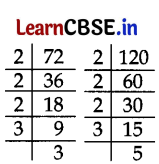
∴ LCM = 23 × 32 × 5 = 360
![]()
Question 22.
A line intersects y-axis and x-axis at point P and Q respectively. If R(2, 5) is the mid-point of line segment PQ, then find the coordinates of P and Q. 2
Answer:
Let P (0, y) and Q (x, 0).
Mid point of PQ = R
(\(\frac{0+x}{2}, \frac{y+0}{2}\)) (2, 5) …[mid-point theorem
⇒ \(\frac{x}{2}\) = 2
⇒ x = 4
⇒ \(\frac{y}{2}\) = 5
⇒ y = 10
∴ Coordinates of P (0, y) = (0, 10)
Coordinates of Q (x, 0) = (4, 0)
Question 23.
Find the length of the shadow on the ground of a pole of height 18 m when angle of elevation θ of the sun is such that tan θ = \(\frac{6}{7}\).
Answer:
In a ΔABC, tan θ = \(\frac{\mathrm{AB}}{\mathrm{BC}}\)
⇒ \(\frac{6}{7}\) = \(\frac{18}{B C}\) …[ tan θ = \(\frac{6}{7}\) …[Given
⇒ 6 BC = 18 × 7
∴ Length of shadow, BC = \(\frac{18 \times 7}{6}\) = 21 m
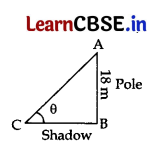
Question 24.
In the given figure, PA is a tangent to the circle drawn from the external point P and PBC is the secant to the circle with BC as diameter.
If ∠AOC = 130°, then find the measure of ∠APB, where O is the centre of the circle. 2
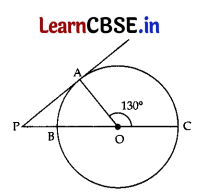
Answer:
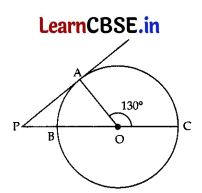
Given. OA is the radius and PA is the tangent.
⇒∠PAO = 90° …[Tangent is ⊥ to the radius through the point of contact
∴ ∠APO + ∠PAO = ∠AOC …[Exterior angle theorem
⇒ ∠APB + 90° = 130°
∴ ∠APB = 130° – 90° = 40°
Question 25.
(a) In the given figure, ABC is a triangle in which DE || BC. If AD = x, DB = x – 2, AE = x + 2 and EC = x – 1, then find the value of x. 2
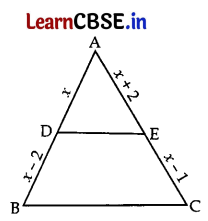
Or
(b) Diagonals AC and BD of trapezium ABCD with AB || DC intersect each other at point O. Show that
\(\frac{\mathrm{OA}}{\mathrm{OC}}\) = \(\frac{\mathrm{OB}}{\mathrm{OD}}\)
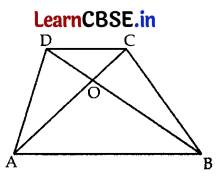
Answer:
(a) In ΔABC, DE || BC
∴ \(\frac{\mathrm{AD}}{\mathrm{BD}}\) = \(\frac{\mathrm{AE}}{\mathrm{EC}}\) …[Thales’ theorem
⇒ \(\frac{x}{x-2}=\frac{x+2}{x-1}\)
⇒ x (x – 1) = (x – 2) (x + 2)
⇒ x2 – x = x2 – 4
∴ x = 4 units
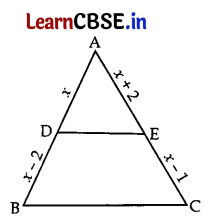
(b) In ΔAOB and ΔCOD,
AB || CD …[Given
∠1 = ∠3 …[Alternate interior angles
∠2 = ∠4
∴ ΔAOB ~ ΔCOD …[By AA corollary
\(\frac{\mathrm{BO}}{\mathrm{DO}}\) = \(\frac{\mathrm{AO}}{\mathrm{CO}}\) ……[In similar Δs corresponding sides are proportional.
∴ \(\frac{\mathrm{OA}}{\mathrm{OC}}\) = \(\frac{\mathrm{OB}}{\mathrm{OD}}\) (Hence proved)
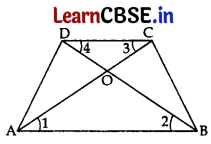
![]()
Section – C
Section C consists of Short Answer (SA) type of questions of 3 marks each.
Question 26.
Find the ratio in which the line segment joining the points A(6, 3) and B(-2, -5) is divided by x-axis. 3
Answer:

Let C (x, 0) be any point on x-axis.
Let AC : CB = m2 : m1 = k : 1
Using section formula, \(\frac{-5 k+3}{k+1}=\frac{0}{1}\)
⇒ -5k + 3 = 0 ⇒ -5k = -3
∴ k = \(\frac{3}{5}\)
∴ Required Ratio = k : 1 = \(\frac{3}{5}\) : 1 or = 3 : 5
Question 27.
(a) Find the HCF and LCM of 26, 65 and 117, using prime factorisation. 3
Or
(b) Prove that √2 is an irrational number.
Answer:
(a) Prime factorisation of 26 = 2 × 13
65 = 5 × 13
117 = 32 × 13
∴ HCF = 13
LCM = 2 × 5 × 32 × 13 = 1170
Or
(b) Let us assume, to the contrary, that √2 is rational. That is, we can find integers a
and b (≠ 0) that √2 = \(\frac{a}{b}\).
Suppose a and b have a common factor other than 1, then we can divide by the common factor and assume that a and b are coprime.
So, b√2 = a
Squaring on both sides, & rearranging, we get 2b2 = a2 Therefore, a2 is divisible by 2 and a is also divisible by 2. So, we can write a = 2c for some integer c. Substituting for a, we get 2b2 = 4c2, that is b2 = 2c2.
This means that b2 is divisible by 2 and so b is also divisible by 2. Therefore, a and b have at least 2 as a common factor. But this contradicts the fact that a and b are coprime.
This contradiction has arisen because of our incorrect assumption that √2 is rational.
So we conclude that √2 is irrational.
Question 28.
In the given figure, Eisapoint on the side CB produced of anisosceles triangle ABC with AB = AC. If AD⊥BC and EF⊥ AC, then prove that triangle ΔABD ~ ΔECF. 3
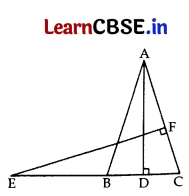
Answer:

In ΔABC, AB = AC …[Given
∴ ∠4 = ∠2 …(i) [Angles opposite equal sides
In ΔABD and ΔECF,
∠3 = ∠1 …[Each 90°
∠4 = ∠2 …[From (i)
∴ ΔABD ~ ΔECF …[AA similarity criterion
Question 29.
(a) The sum of two numbers is 15. If the sum of their reciprocals is \(\frac{3}{10}\), find the two numbers. 3
Or
(b) If α and β are roots of the quadratic equation x2 – 7x + 10 = 0, find the quadratic equation , whose roots are α2 and β2. 3
Answer:
(a) Let two numbers be x and 15 – x. According to question,
⇒ \(\frac{1}{x}+\frac{1}{15-x}=\frac{3}{10}[latex] ⇒ [latex]\frac{15-x+x}{x(15-x)}=\frac{3}{10}[latex]
⇒ 150 = 3x(15 – x) ⇒ 50 = 15x – x2
⇒ x2 – 15x + 50 = 0
⇒ x2 – 10x – 5x + 50 = 0
⇒ x(x – 10) -5 (x – 10) = 0
⇒ (x – 5) (x – 10) = 0
⇒ x – 5 = 0 or x – 10 = 0
⇒ x = 5 or x = 10
When x = 5, numbers are 5, 10
When x = 10, numbers are 10, 5
Or
(b) Given, x2 – 7x + 10 = 0
a = 1, b = -7, c = 10
Sum of roots, α + β = [latex]\frac{-b}{a}=\frac{-(-7)}{1}\) = 7 …(i)
Product of roots, αβ = \(\frac{c}{a}\) = 10 …(ii)
For required Polynomial,
Sum of roots, S = α2 + β2 = (α + β)2 – 2αβ
= (7)2 – 2(10) …[From (i) and (ii)
= 49 – 20 = 29
Product of roots, P = α2β2
= (αβ)2 …[From (ii)
= (10)2 = 100
∴ Required Quadratic Polynomial,
x2 – Sx + P = 0 ∴ x2 – 29x + 100 = 0
![]()
Question 30.
Prove that: \(\frac{1+\sec A}{\sec A}=\frac{\sin ^2 A}{1-\cos A}\) 3
Answer:

Question 31.
In a circle of radius 21 cm, an arc subtends an angle of 60° at the centre. Find the area of the sector formed by the arc. Also, find the length of the arc. 3
Answer:
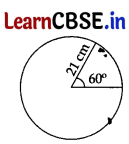
Here r = 21 cm, θ = 60°
Area of sector = \(\frac{\theta}{360^{\circ}}\)πr2
= \(\frac{60^{\circ}}{360^{\circ}}\) × \(\frac{22}{7}\) × 21 × 21
= 231 cm2
Length of an arc = \(\frac{\theta}{360^{\circ}}\) (2πr)
= \(\frac{60^{\circ}}{360^{\circ}}\) × 2 × \(\frac{22}{7}\) × 21 = 22 cm
Section – D
Section D Consists of Long Answer (LA) type questions of 5 marks each.
Question 32.
(a) Two tangents TP and TQ are drawn to a circle with centre O from an external point T. Prove that ∠PTQ = 2 ∠OPQ. 5
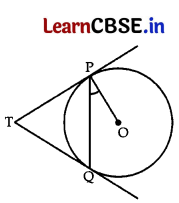
Or
(b) A circle touches the side BC of a ΔABC at a point P and touches AB and AC when produced at Q and R respectively.
Show that AQ = \(\frac{1}{2}\) (Perimeter of ΔABC).
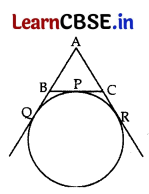
Answer:
(a) Given. A circle with centre O, an external point T and two tangents TP and TQ to the circle, where P, Q are the points of contact.
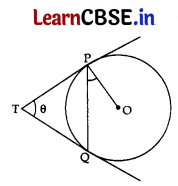
To Prove. ∠PTQ = 2∠OPQ
Proof: Let ∠PTQ = θ
Now, TP = TQ ……[∵ Lengths of tangents drawn from an external Point to a circle are equal
So, TPQ is an isosceles triangle
∴ ∠TPQ = ∠TQP = \(\frac{1}{2}\) (180° – θ)
= 90° – \(\frac{1}{2}\)θ …….. (i)
Also, ∠OPT = 90° ……[∵Tangent at any point of a circle is⊥to radius through the pt. of contact
So, ∠OPQ = ∠OPT – ∠TPQ = 90° – (90° – \(\frac{1}{2}\) θ) …….[From (i)
∠OPQ = \(\frac{1}{2}\) θ ⇒ ∠OPQ = \(\frac{1}{2}\) ∠PTQ
∴ ∠PTQ = 2∠OPQ (Hence Proved)
Or
(b) Since the tangents from an external point to a circle are equal in length.
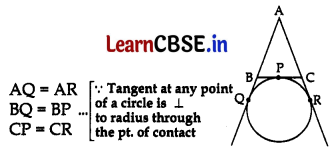
Now, Perimeter of ΔABC = AB + BC + AC
= AQ – BQ + BP + PC + AR – CR
= AQ – BP + BP + CR + AQ – CR …[Using (i), (ii) and (iii)
∴ Perimeter of ΔABC = 2AQ
AQ = \(\frac{1}{2}\) (Perimeter of ΔABC)
(Hence Proved)
Question 33.
A solid is in the shape of a right-circular cone surmounted on a hemisphere, the radius of each of them being 7 cm and the height of the cone is equal to its diameter. Find the volume of the solid. 5
Answer:
Given, r = 7 cm, h = 2r = 14 cm
Vol. of solid = Vol. of cone + Vol. of hemisphere
= \(\frac{1}{3}\)πr2h + \(\frac{2}{3}\)πr3 = \(\frac{1}{3}\) πr2 (h + 2r)
= \(\frac{1}{3}\) × \(\frac{22}{7}\) × 7 × 7 (14 + 14)
= \(\frac{22 \times 7 \times 28}{3}\) \(\frac{4312}{3}\)
= 1437.3 cm3
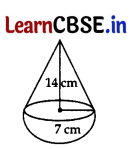
Question 34.
(a) The ratio of the 11th term to the 18th term of an AP is 2 : 3. Find the ratio of the 5th term to the 21st term. Also, find the ratio of the sum of first 5 terms to the sum of first 21 terms. 5
Or
(b) If the sum of first 6 terms of an AP is 36 and that of the first 16 terms is 256, find the sum of first 10 terms.
Mass (in grams) 80-100 100-120 120-140 140-160 160-180
Number of apples 20 60 70 X 60
Answer:
(a) \(\frac{a_{11}}{a_{18}}\) = \(\frac{2}{3}\) …[Given
\(\frac{a+10 d}{a+17 d}\) = \(\frac{2}{3}\) …[∵ an = a + (n – 1)d
⇒ 3a + 30d = 2a + 34 d
⇒ 3a – 2a = 34d + -30d
a = 4d …… (i)
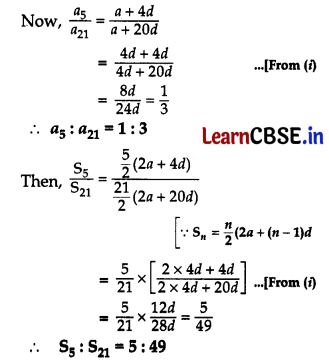
Or
(b) Given. S6 = 36
⇒ \(\frac{6}{2}\)(2a + 5d) = 36 … [∵ Sn = \(\frac{n}{2}\)(2a + (n – 1 )d
⇒ 2a + 5d = 12 ⇒ 2a = 12 – 5d ……. (i)
and S16 256 …..[Given
⇒ \(\frac{16}{2}\) (2a + 15d) = 256
⇒ 2a + 15d = \(\frac{256}{2}\)
⇒ 12 – 5d + 15d = 32 …..[From (i)
10d = 32 – 12
∴ d \(\frac{20}{10}\) = 2
From (i), 2a = 12 – 5(2)
⇒ 2a = 2 :. a = 1
As we know, Sn = \(\frac{n}{2}\) [2a + (n – 1)d]
∴ S10 = \(\frac{10}{2}\)(2a + 9d)
= 5 (2(1) + 9(2))
= 5 (2 + 18) = 5 (20) = 100
![]()
Question 35.
250 apples of a box were weighed and the distribution of masses of the apples is given in Find the value of x and the mean mass of the apples.

(ii) Find the modal mass of the apples.
Answer:
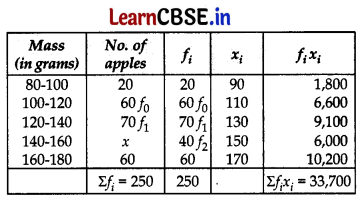
Total Apples = 250 …..[Given
⇒ 20 + 60 + 70 + x + 60 = 250
⇒ 210 + x = 250
∴ x = 250 – 210 = 40
(i) Mean Mass = \(\frac{\Sigma f_i x_i}{\Sigma f_i}\)
= \(\frac{33700}{250}\) = 134.8 gms
(ii) Since Maximum Frequency is 70
So Modal class in 120 – 140
∴ Modal mass = l + \(\frac{f_1-f_0}{2 f_1-f_0-f_2}\) × h ..[Here, l = 120, f0 = 60, f1 = 70, f2 = 40, h = 20
= 120 + \(\frac{70-60}{140-60-40}\) × 20
= 120 + \(\frac{10 \times 20}{40}\)
h = 20
= 120 + 5 = 125 gms
Section – E
3 Case Study Based Questions. Each question is of 4 marks.
Question 36.
A coaching institute of Mathematics conducts classes in two batches I and II and fees for rich and poor children are different. In batch I, there are 20 poor and 5 rich children, whereas in batch II, there are 5 poor and 25 rich children. The total monthly collection of fees from batch I is ₹9000 and ‘from batch II is ₹26,000. Assume that each” poor child
pays ₹ x per month and each rich child pays ₹ y per month.
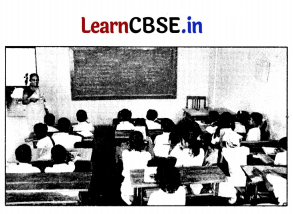
Based on the above information, answer the following questions :
(i) Represent the information given above in terms of x and y. 1
(ii) Find the monthly fee paid by a poor child. 2
Or
Find the difference in the monthly fee paid by a poor child and a rich child. 2
(iii) If there are 10 poor and 20 rich children in batch III, what is the total monthly collection of fees from batch III? 1
Answer:
(i) A.T.Q. 20x + 5y = 9,000 ……(A)
5x + 25 y = 26,000 …….(B)
(ii) Multiplying (A) by 1 and (B) by \(\frac{1}{5}\) we have

∴ x = \(\frac{3800}{19}\) = ₹200
From (C), 200 + 5y = 5200
⇒ 5y = 5200 – 200
∴ y = \(\frac{5000}{5}\) = ₹1,000
∴ Monthly fee paid by a poor child x = ₹200
∴ Required difference = y – x
= ₹(1,000 – 200) = ₹800
(iii) Total collection of Fees from Batch III
= 10x + 20y
= 10(200) + 20(1,000) …[From Point (ii)
= 2,000 + 20,000 = ₹22,000
Question 37.
Radio towers are used for transmitting a range of communication services including radio and television. The tower will either act as an antenna itself or support one or more antennas on its structure. On a similar concept, a radio station tower was built in two Sections A and B. Tower is supported by wires from a point O.
Distance between the base of the tower and point O is 36 cm. From point O, the angle of elevation of the top of the Section B is 30° and the angle of elevation of the top of Section A is 45°.
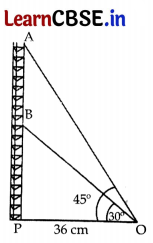
Based on the above information, answer the following questions :
(i) Find the length of the wire from the point O to the top of Section B. 1
(ii) Find the distance AB. 2
Find the area of ΔOPB,
(iii) Find the height of the Section A from the base of the tower. 1
Answer:
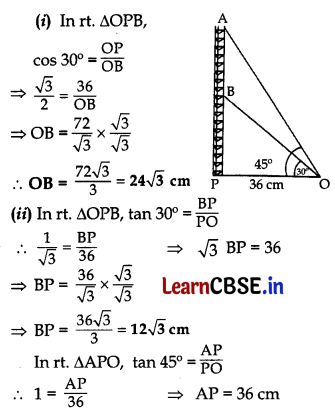
∴ AB = AP – BP = 36 – 12√3
= 12(3 – √3)cm or 12√3(√3 – 1) cm
Or
ar. (ΔOPB) = \(\frac{1}{2}\) × Base × height
= \(\frac{1}{2}\) × PO × PB
= \(\frac{1}{2}\) × 36 × 12√3
= 216√3 cm3
(iii) From (ii) above AP = 36 cm
Alternatively, AP = AB + BP
AP = AB + BP
= 12√3(√3 – 1) + 12√3
= 36 – 12√3 + 12√3 = 36 cm
![]()
Question 38.
“Eight Ball” is a game played on a pool table with 15 balls numbered 1 to 15 and a “cue ball” that is solid and white. Of the 15 numbered balls, eight are solid (non-white) coloured and numbered 1 to 8 and seven are striped balls numbered 9 to 15.
The 15 numbered pool balls (no cue ball) are placed in a large bowl and mixed, then one ball is drawn out at random.
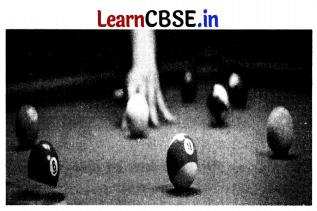
Based on the above information, answer the following questions :
(i) What is the probability that the drawn ball bears number 8? 1
(ii) What is the probability that the drawn ball bears an even number? 2
What is the probability that the drawn ball bears a number, which is a multiple of 3?
(in) What is the probability that the drawn ball is a solid coloured and bears an even number? 1
Answer:
Non-White balls = 8 (nos. 1 to 8)
Striped balls = 7 (nos. 9 to 15)
White solid cue ball = 1
Total number of balls = 8 + 7 = 15
(i) P(number 8 ball) = \(\frac{1}{15}\) …[There is one eight number ball
(ii) Even balls 2,4, 6,8,10,12,14 i.e 7 balls 7
∴ P(even number) = \(\frac{7}{15}\)
Or
“Multiples of 3” are 3, 6, 9, 12, 15 i.e 5 balls
∴ P(multiple of 3) = \(\frac{5}{15}\) = \(\frac{1}{3}\)
(iii) Solid coloured and bear even number balls are 2, 4, 6, 8 i.e 4 balls
∴ Required probability = \(\frac{4}{15}\)
SET Code No. 30/6/2
Note: Except for the following questions, all the remaining questions have been asked in Set – I.
Question 6.
The LCM of smallest 2-digit number and smallest composite number is 1
(a) 12
(b) 4
(c) 20
(d) 40
Answer:
(c) 20
Smallest 2 digit number = 10 = 2 × 5
Smallest composite number = 4 = 22
∴ LCM (10,4) = 22 × 5 = 20
Question 7.
The distance of the point (-4, 3) from y-axis is 1
(a) -4
(b) 4
(c) 3
(d) 5
Answer:
(b) 4
Distance of (-4, 3) from y-axis is 4.
Note : Distance is not negative.
Question 8.
If one zero of the polynomial x2 + 3x + k is 2, then the value of k. 1
(a) -10
(b) 10
(c) 5
(d) -5
Answer:
(a) -10
Let P(x) = x2 + 3x + k
∴ x = 2 …[ ∵ 2 is a zero of P(x)
⇒ (2)2 + 3(2) + k = 0
⇒ 4 + 6 + k = 0 ∴ k = -10
Question 16.
A box contains 90 discs, numbered from 1 to 90. If one disc is drawn at random from the box, the probability that it bears a prime number less than 23 is 1
(a) \(\frac{7}{90}\)
(b) \(\frac{1}{9}\)
(c) \(\frac{4}{45}\)
(d) \(\frac{9}{89}\)
Answer:
(c) \(\frac{4}{45}\)
Let x be the Prime number less than 23 Such numbers are 2, 3, 5, 7, 11, 13, 17, 19 i.e 8
∴ P(x) = \(\frac{8}{90}\) = \(\frac{4}{45}\)
Question 17.
The coordinates of the point where the line 2y = 4x + 5 crosses ar-axis is 1
(a) (o, \(\frac{-5}{4}\))
(b) (o, \(\frac{5}{2}\))
(c) (\(\frac{-5}{4}\), 0)
(d) (\(\frac{-5}{2}\), o)
Answer:
(c) (\(\frac{-5}{4}\), 0)
Given. 2y = 4x + 5
∴ 2(0) – 5 = 4x …[To cut x-axis, y = 0
∴ x = \(\frac{-5}{4}\)
∴ Point (x, y) = (\(\frac{-5}{4}\), 0)
![]()
Question 18.
(cos4 A – sin4 A) on simplification, gives 1
(a) 2 sin2 A – 1
(b) 2 sin2 A + 1
(c) 2 cos2 A + 1
(d) 2 cos2 A – 1
Answer:
(d) 2 cos2 A – 1
Given, cos4 A – sin4 A
= (cos2 A)2 – (sin2 A)2
= (cos2 A – sin2 A) (cos2 A + sin2 A)
= [(cos2 A – (1 – cos2 A)]. (1)
= [(cos2 A – 1 + cos2 A]. 1 = 2 cos2 A – 1
Question 24.
Find the points on the x-axis, each of which is at a distance of 10 units from the point A(11, -8). 2
Answer:
Let B(x, 0) be any point on x-axis.
AB = 10 units …[Given
(AB)2 = 100 …[Squaring both sides
⇒ (x – 11)2 + (0 + 8)2 = 100
⇒ (x – 11)2 + 64 = 100
⇒ (x – 11)2 = 100 – 64
⇒ (x – 11)2 = 36
⇒ x – 11 = ±6 …[Taking Square-root on both sides
⇒ x = 11 ±6
⇒ x = 11 + 6 or x = 11 – 6
∴ x = 17 or x = 5
∴ B = (17, 0) or (5,0)
Question 26.
In the given figure, AB and CD are diameters of a circle with centre O perpendicular to each other. If OA = 7 cm, find the area of shaded region. 3
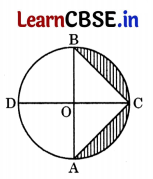
Answer:
Area of shaded region
= Area of Semi-circle – Ar. (ΔABC)
= \(\frac{1}{2}\)πr2 – \(\frac{1}{2}\) × AB × OC
= \(\frac{1}{2}\) × \(\frac{22}{7}\) × 7 × 7 – \(\frac{1}{2}\) × 14 × 7 [∵ AB = 7 + 7 = 14cm OC = r = 7 cm ]
= 77 – 49 = 28 cm2
Question 27.
If sin θ + cos θ = p and sec θ + cosec θ = q, then prove that q(p2 – 1) = 2p. 3
Answer:
We have, p = sin θ + cos θ
q = sec θ + cosec θ
L.H.S. q (p2 – 1)
= (sec θ + cosec θ) [(sin θ + cos θ)2 – 1]
= (\(\frac{1}{\cos \theta}+\frac{1}{\sin \theta}\)) (sin2 θ + cos2 θ + 2sin θ cos θ – 1)
= (\(\frac{\sin \theta+\cos \theta}{\cos \theta \sin \theta}\)) (2 sin θ cos θ)…[∵ sin2 θ + cos2 θ = 1
= 2 (sin θ + cos θ)
= 2p = R.H.S (Hence Proved)
Question 34.
A solid is in the shape of a right-cirular cone surmounted on a hemisphere, the radius of each of them being 3.5 cm and the total height of the solid is 9.5 cm. Find the volume of the soild. 5
Answer:
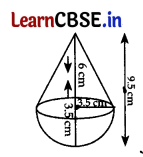
r = 3.5 cm or \(\frac{7}{2}\) cm
Height of cone, h =9.5 – 3.5
= 6 cm
∴ Vol. of solid = Vol. of cone + Vol. of hemisphere
= \(\frac{1}{2}\) πr2h + \(\frac{2}{3}\) πr3
= \(\frac{1}{2}\) πr2 (h + 2r)
= \(\frac{1}{3}\) × \(\frac{22}{7}\) × \(\frac{7}{2}\) × \(\frac{7}{2}\) × (6 + 2 × \(\frac{7}{2}\))
= \(\frac{77}{3}\) × 13 = \(\frac{1001}{6}\) = \(166.8 \overline{3}\) cm3
Question 35.
(a) Find the sum of integers between 100 and 200 which are 5
(i) divisible by 9
(ii) not divisible by 9.
Or
(b) Solve the equation : -4 + (-1) + 2 + 5 + ………. + x = 437.
Answer:
(a) (i) Nos. divisible by 9 between 100 & 200 are
108, 117, 126, ………… an
Here a = 108, d = 117 – 108 = 9, an – 198
∴ a + (n – 1) d = an
⇒ 108 + (n – 1) 9 = 198
⇒ (n – 1)9 = 198 – 108
⇒ (n – 1) = \(\frac{90}{9}\) ∴ n = 11
Now, Sn = \(\frac{n}{2}\) (a1 + an)
S11 = \(\frac{11}{2}\) (108 + 198)
= \(\frac{11}{2}\) × 306 = 11 × 153 = 1683
(ii) Let S be the sum of integers between 100 and 200.
∴ S = 101 + 102 + 103 + ………… + 199
Here a1 = 101, an = 199,
n = 199 – 101 + 1 = 99
∴ S = \(\frac{99}{2}\) (101 + 199)
= \(\frac{99}{2}\) (300) = 99 × 150 = 14,850
Now, Sum not divisible by 9 = 14850 – 1683 = 13167
Or
(b) Here, a = -4, d = -1 – (-4) = 3, an = x
Given. Sn = 437
∴ \(\frac{n}{2}\) [2a + (n – 1) (d)] = 437
⇒ \(\frac{n}{2}\) [2 (-4) + (n – 1)(3)] = 437
⇒ n (-8 + 3n – 3) = 874
⇒ n (3n – 11) = 874
⇒ 3n2 – 11n – 874 = 0
⇒ 3n2 – 57n + 46n – 874 = 0
⇒ 3n(n – 19) + 46 (n – 19) = 0
⇒ (n – 19) (3n + 46) = 0
⇒ n – 19 = 0 or 3n + 46 = 0
∴ n = 19 or n = \(\frac{-46}{3}\) (Not possible) …[n must be a rational number
Now, x = an
x = a + (n – 1)d
= -4 + (19 – 1)(3) = -4 + 54 = 50
*Note: 2nd Method using x = \(\frac{-b \pm \sqrt{b^2-4 a c}}{2 a}\)
![]()
SET III Code. 30/6/3
Note: Except for the following questions, all tire remaining questions have been asked in Set – I and Set II.
Question 1.
The distance between the points (0, 5) and (-3, 1) is :
(a) 8 units
(b) 5 units
(c) 3 units
(d) 25 units
Answer:
(b) 5 units
Given. A (0, 5) and B (-3, 1)
∴ AB = \(\sqrt{(-3-0)^2+(1-5)^2}\) …[Using distance formula
= \(\sqrt{9+16}\) = \(\sqrt{25}\) = 5 units
Question 2.
If tan θ = \(\frac{x}{y}\), then cos θ is equal to
Answer:
(a) \(\frac{x}{\sqrt{x^2+y^2}}\)
(b) \(\frac{y}{\sqrt{x^2+y^2}}\)
(c) \(\frac{x}{\sqrt{x^2-y^2}}\)
(d) \(\frac{y}{\sqrt{x^2-y^2}}\)
Answer:
(b) \(\frac{y}{\sqrt{x^2+y^2}}\)
Given, tan θ = \(\frac{x}{y}\)
As we know, sec2 θ = 1 + tan2 θ
sec2 θ = 1 + \(\frac{x^2}{y^2}\)
⇒ sec2 θ = \(\frac{y^2+x^2}{y^2}\)
⇒ sec θ = \(\sqrt{\frac{x^2+y^2}{y^2}}=\frac{\sqrt{x^2+y^2}}{y}\)
∴ cos θ = \(\frac{1}{\sec \theta}=\frac{y}{\sqrt{x^2+y^2}}\)
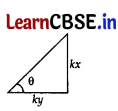
Alternatively, tan θ = \(\frac{x}{y}=\frac{\mathrm{P}}{\mathrm{B}}\)
In rt. Δ, H2 = P2 + B2
= k2x2 + k2y2 …[Pythagoras’ theorem
⇒ H2 = k2 (x2 + y2)
⇒ H = k\(\sqrt{x^2+y^2}\)
∴ cos θ \(\frac{\mathrm{B}}{\mathrm{H}}=\frac{k y}{k \sqrt{x^2+y^2}}=\frac{y}{\sqrt{x^2+y^2}}\)
Question 3.
The zeroes of the polynomial 3x2 + 11x -4 are:
(a) \(\frac{1}{3}\), -4
(b) \(\frac{-1}{3}\), 4
(c) \(\frac{1}{3}\), 4
(d) \(\frac{-1}{3}\), 4
Answer:
(a) \(\frac{1}{3}\), -4
Given. 3x2 + 11x – 4
⇒ 3x2 + 12x – x – 4
⇒ 3x (x + 4) – 1(x + 4)
⇒ (x + 4) (3x – 1)
∴ Zeroes are: x + 4 = 0 or 3x – 1 = 0
x = -4 or x = 1/3
Question 16.
If ‘p’ is a root of the quadratic equation x2 – (p + q) x + k = 0 then the value of ‘k’ is
(a) p
(b) q
(c) p + q
(d) pq
Answer:
(d) pq
Given. x2 – (p + q)x + k = 0
Since p is one of the root, …[Given
∴ p2 – (p + q)p + k = 0
⇒ p2 – p2 – pq + k = 0 ∴ k = pq
Question 17.
Cards bearing numbers 3 to 20 are placed in a bag and mixed thoroughly. A card is taken out of the bag at random. What is the probability that the number on the card taken out is an even number? 1
(a) \(\frac{9}{17}\)
(b) \(\frac{1}{2}\)
(c) \(\frac{5}{9}\)
(d) \(\frac{7}{18}\)
Answer:
(b) \(\frac{1}{2}\)
We have, 3, 4, 5 ………….. 20
Total cards = 18
Even number cards are 4, 6, 8, 10, 12, 14, 16, 18, 20 i.e., 9
∴ P(even numbers) = \(\frac{9}{18}\) = \(\frac{1}{2}\)
Question 18.
The condition for the system of linear equations ax + by = c; lx + my = n have a unique solution is 1
(a) am ≠ bl
(b) al ≠ bm
(c) al = bm
(d) am = bl
Answer:
(a) am ≠ bl
Given, ax + by = c
lx + my = n
For unique solution: \(\frac{a_1}{a_2} \neq \frac{b_1}{b_2}\)
\(\frac{a}{l} \neq \frac{b}{m}\)
∴ am ≠ bl
![]()
Question 21.
Find the ratio in which the y-axis divides the line segment joining the points (5, -6) and (-1, -4). 2
Answer:
Let C(0,y) be any point on y-axis.

Let AC : CB = k : 1
Coordinates of C = Coordinates of C
\(\frac{-k+5}{k+1}, \frac{-4 k-6}{k+1}\) = (0, y) ..[Using formula
⇒ \(\frac{-k+5}{k+1}\) = 0 ⇒ -k + 5
∴ k = 5
∴ Required Ratio = k : 1 = 5: 1
Question 26.
Prove that (sin θ + cos θ) (tan θ + cot θ) = sec θ + cosec θ. 3
Answer:
L.H.S = (sin θ + cos θ) (tan θ + cot θ)
= (sin θ + cos θ) (\(\frac{\sin \theta}{\cos \theta}+\frac{\cos \theta}{\sin \theta}\))
= (sin θ + cos θ) (\(\frac{\sin ^2 \theta+\cos ^2 \theta}{\cos \theta \sin \theta}\))
= \(\frac{\sin \theta+\cos \theta}{\sin \theta \cos \theta}\) ….[∵ sin2 θ + cos2 θ = 1
\(\frac{\sin \theta}{\sin \theta \cos \theta}+\frac{\cos \theta}{\sin \theta \cos \theta}\)
= sec θ+ cosec θ = R.H.S (Hence Proved)
Question 27.
(a) A natural number, when increased by 12, equals 160 times its reciprocal. Find the number. 3
Or
(b) If one root of the quadratic equation x2 + 12x – k = 0 is thrice the other root, then find the value of k.
Answer:
(a) Let the number be x.
A.T.Q., (x + 12) = 16o(\(\frac{1}{x}\))
x (x + 12) = 160
⇒ x2 + 12x – 160 = 0
⇒ x2 + 20x – 8x – 160 = 0
⇒ (x – 8) (x + 20) = 0
⇒ x – 8 = 0 or x + 20 = 0
⇒ x = 8 or x = -20 (not possible)
Natural number must be positive
∴ Required number, x = 8.
Or
(b) Given, x2 + 12x + k = 0. Let roots be α and 3α
Here a = 1, b = 12, c = -k
Sum of roots = \(\frac{-b}{a}\)
α + 3α = \(\frac{-12}{1}\)
4α = -12
∴ α = -3 ….. (i)
Product of roots = \(\frac{c}{a}\)
α(3α) = \(\frac{-k}{1}\)
3α2 = -k
3(-3)2 = -k ….[From (i)
∴ k = -27
Question 32.
(a) The sum of first seven terms of an A.P. is 182. If its 4th term and the 17th term are in the ratio 1: 5, find the A.P. 5
Or
(b) The sum of first q terms of an A.P. is 63q – 3q2. If its pth term is – 60, find the value of p. Also, find the 11th term of this A.P.
Answer:
(a) S7 = 182
⇒ \(\frac{7}{2}\) (2a + 6d) = 182 …[∵ Sn = \(\frac{n}{2}\) (2a + (n – 1)d
⇒ (a + 3d) = \(\frac{182}{7}\) ⇒ a + 3d = 26
⇒ a = 26 – 3d …… (i)
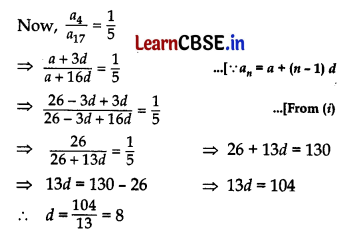
From (i), a = 26 – 3 (8) = 26 – 24 = 2
∴ AP is a, a + d, a + 2d, a + 3d, 2, 10, 18, 26..
Or
(b) Given. Sq = 63q – 3q2
Put q = 1, S1 = 63(1) – 3(1)2 = 63 – 3 = 60
Put q = 2, S2 = 63(2) – 3(2)2 = 126 – 12 = 114
a1 = S1 = 60
a2 = S2 – S1 = 114 – 60 = 54
d = a2 – a1
= 54 – 60 = -6
Now, ap = -60
⇒ a + (p – 1 )d = -60 …[∵ a = a1 = 60
⇒ 60 + (p – 1)(-6) = -60
⇒ (p -1 )(-6) = -60 – 60
⇒ P – 1 = \(\frac{-120}{-6}\)
∴ p = 20 + 1 = 21
Now, a11 = a + 10d = 60 + 10(-6) = 60 – 60 = 0
Question 33.
(a) Prove that a parallelogram circumscribing a circle is a rhombus. 5
Or
(b) In the given figure, tangents PQ and PR are drawn to a circle such that ∠RPQ 30°. A chord RS is drawn parallel to the tangent PQ. Find the measure of ∠RQS.
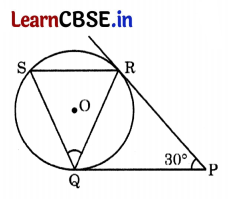
Answer:
(a)
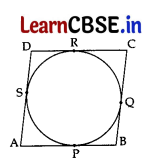
Given. ABCD is a ||gm.
To prove. ABCD is a rhombus.
Proof. In || Sm, opposite sides are equal
∴ AB = CD
and AD = BC ……. (i)

By adding these tangents,
(AP + PB) + (CR + DR) = AS + BQ + CQ + DS
⇒ AB + CD = (AS + DS) + (BQ + CQ)
⇒ AB + CD = AD + BC
⇒ AB + AB = BC + BC ……[From (i)
⇒ 2AB = 2BC
⇒ AB = BC …….(ii)
From (i) and (ii), AB = BC = CD = DA
∴ ||gm ABCD is a rhombus.
Or
(b)
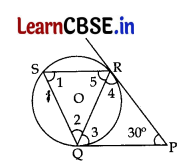
Given. ∠RPQ = 30°
To find the value of = ∠RQS
Proof: PQ = PR …[Tangents drawn from an external point are equal
∴ In ΔPQR, ∠3 = ∠4 …[Angles opposite to equal sides
∴ In ΔPQR, ∠3 + ∠4 + ∠30° = 180° …….(i)
…[Angles sum Property of a Δ
⇒ ∠3 + ∠3 + 30° = 180° …[From (i)
⇒ 2∠3 = 180° – 30° = 150°
⇒ ∠3 = \(\frac{150}{2}\) = 75°
∴ ∠3 = ∠4 = 75° ……(ii)
RS || PQ …[Given
∠5 = ∠3 = 75° …(iii) …[Alternate Interior angles
PQ is a tangent and QR is a chord.
∠1 = ∠3 = 75° …[Angles in the alternate segments
In ΔQRS, ∠1 + ∠2 + ∠5 = 180° …[Angles-sum-Property of a Δ
⇒ 75° + ∠2 + 75° = 180° …[From (ii) and (iii)
⇒ ∠2 = 180° – 75° – 75°
∴ ∠2 or ∠RQS = 30°